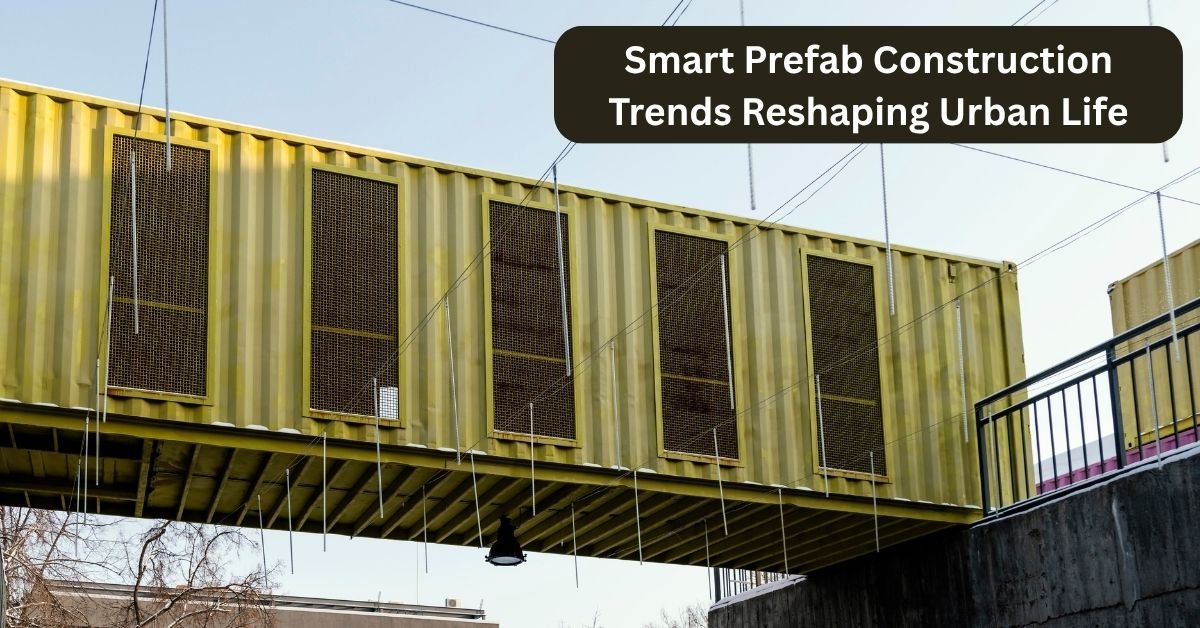The global push for smarter, greener, and faster construction has spotlighted prefab container homes as a transformative solution, especially in rapidly urbanizing cities. These modular, factory-built structures are not only redefining residential possibilities but also playing a significant role in solving space constraints and boosting sustainability in urban settings.
As cityscapes evolve and urban populations swell, traditional construction methods are struggling to keep pace with housing and infrastructure demands. Smart prefab construction trends are emerging as viable answers, offering time efficiency, cost control, eco-friendliness, and flexibility — traits that align perfectly with modern urban challenges.
1. Understanding Smart Prefab Construction in Urban Settings
Smart prefab construction refers to the use of intelligent, modular building components that are manufactured off-site under controlled conditions and assembled on-site with minimal environmental disruption. Unlike conventional brick-and-mortar buildings, prefab homes and offices follow a streamlined process that reduces material wastage, ensures high precision, and accelerates project timelines.
This innovation is rapidly gaining attention in regions like the Middle East, particularly with the rise in container homes in Dubai, where the blend of luxury, sustainability, and rapid development is crucial. In such environments, smart prefab solutions meet urban design needs while adapting to climate and zoning constraints.
2. Growing Urban Demand for Prefab Container Homes
As cities become denser and land becomes scarce, the demand for compact, affordable, and sustainable living units has intensified. This is where prefab container homes shine. Originally designed for temporary or emergency housing, these steel-framed modular units are now being reimagined into trendy urban dwellings, luxury studios, cafes, coworking spaces, and even educational institutions.
Why are they gaining popularity?
- Affordability: Compared to traditional buildings, container homes require less labor and fewer resources.
- Speed: Off-site fabrication can take place simultaneously with on-site groundwork, cutting down completion time drastically.
- Adaptability: Easily relocated, resized, or reconfigured, container homes offer urban residents and developers much-needed flexibility.
3. Eco-Friendly Urbanization: Sustainability at Core
The push toward sustainable urban development has never been stronger. Cities are under increasing pressure to reduce their carbon footprints, manage energy consumption, and minimize environmental impact. Prefab construction methods align perfectly with these sustainability goals.
Key environmental benefits include:
- Reduced material wastage: Precision manufacturing cuts down on-site waste.
- Lower carbon emissions: Streamlined logistics and faster construction reduce overall emissions.
- Energy-efficient designs: Integration of solar panels, smart insulation, and energy-saving appliances is easier in prefab structures
For eco-conscious cities like Dubai, embracing container homes within the urban fabric is both a strategic and ethical decision, offering a cleaner and greener lifestyle without sacrificing modern amenities.
4. Integration of Smart Technologies in Prefab Designs
Another defining aspect of smart prefab construction is the seamless integration of cutting-edge technology. Homes built using this method can be equipped with:
- Smart HVAC systems
- Automated lighting and security
- IoT sensors for energy monitoring
- Voice-activated systems
These smart-enabled prefab structures offer residents a blend of comfort, convenience, and energy optimization, making them especially suitable for tech-savvy urban dwellers. As smart cities evolve, having homes that can connect and communicate within larger digital ecosystems will no longer be optional—it will be essential.
5. Aesthetics and Customisation: Beyond the Box
Gone are the days when container homes were considered boxy and bland. With design innovation and architectural creativity, today’s prefab homes offer:
- Sleek exteriors with cladding and finishes
- Spacious interiors with multi-functional furniture
- Modular expansion options for growing families or businesses
- Custom facades to reflect personal or brand identity
Urban residents are seeking housing that reflects their lifestyle while being adaptable and cost-efficient. Prefab construction now delivers both form and function, balancing aesthetics with practicality.
6. Resilience and Safety Standards in Modern Prefab Builds
Prefab homes, especially those made from shipping containers, are inherently strong and durable. With added insulation, fireproofing, and weatherproofing treatments, these homes meet or exceed most urban building codes.
Some notable resilience features include:
- Steel-reinforced structures
- Resistance to mold, pests, and corrosion
- Enhanced safety during earthquakes or storms
Urban planners are increasingly relying on prefab models to develop affordable housing in vulnerable areas due to their proven durability and faster deployment capabilities.
7. Prefab Solutions for Urban Infrastructure and Commercial Use
While prefab container homes dominate headlines, modular construction is also revolutionizing commercial infrastructure in cities. Examples include:
- Pop-up retail outlets and cafes
- Mobile clinics and healthcare pods
- Modular classrooms and temporary learning centers
- Coworking hubs and innovation labs
Cities like Dubai are leveraging container modification techniques to transform underutilized plots into thriving commercial spots. These structures can be disassembled, relocated, or scaled up depending on demand — a major advantage for fast-paced urban economies.
8. Cost Dynamics: Affordable Luxury in Urban Markets
Contrary to popular belief, smart prefab construction doesn’t equate to budget housing alone. It ranges from ultra-affordable units to high-end modular villas, especially in cities promoting luxury with sustainability — a combination seen in the rise of container homes in Dubai.
While the upfront cost might be slightly higher due to smart systems or customization, the long-term savings in energy, maintenance, and adaptability justify the investment.
Moreover, governments and urban developers are increasingly supporting prefab housing through tax incentives, land lease schemes, and fast-track building permits, further boosting adoption.
9. Urban Lifestyle Compatibility: Prefab for the Modern Resident
Today’s urban residents crave convenience, mobility, and eco-conscious living. Smart prefab construction caters directly to these needs through:
- Fast move-in timelines
- Compact designs for city centers
- Eco-tech integrations
- Mobility and scalability
From single professionals to families and entrepreneurs, prefab homes offer a versatile lifestyle solution that adapts to various life stages and income brackets.
10. Global Influence and the Future of Prefab in Urban Areas
As urban centers across the globe grapple with housing shortages and environmental concerns, the smart prefab trend continues to gain traction. Dubai, with its forward-thinking development strategies, is at the forefront of this movement.
Emerging innovations in prefab architecture are setting the stage for:
- Floating container homes and overwater housing
- Vertical stacking solutions for micro-living
- AI-driven prefab design and construction automation
- Circular construction using reused materials
By 2030, it’s anticipated that prefab will account for a significant share of urban construction projects globally, pushing cities toward smarter and more efficient development models.
Conclusion: A Smarter Way to Build Urban Futures
Smart prefab construction is not just a trend—it’s a movement reshaping the way cities build and live. By leveraging modularity, technology, sustainability, and adaptability, these solutions address the core challenges of urban living: space, speed, cost, and carbon.
With increasing acceptance of prefab container homes and the versatility shown in container homes Dubai, urban centers are setting examples for sustainable living without compromising on quality or design. The future of construction lies in smarter, faster, and greener builds — and prefab leads the way.


